John Francis Kavanagh
John Francis Kavanagh (24 September 1903 – 18 June 1984) was an Irish sculptor and artist. In 1930 he was awarded the British School at Rome Scholarship in Sculpture.[1]
In 1933 he was appointed Head of Department of Sculpture and Modelling at the Leeds College of Art.[2]
He was an Associate member of the Royal British Society of Sculptors from 1935, and elected a Fellow in 1945. In 1951 he took up the post of Senior Lecturer in Sculpture at the Elam School of Fine Arts, Auckland, New Zealand.[3]

Early life and education
John Francis Kavanagh was born in Crinkill Barracks, Birr, County Offaly, eldest son of John Michael Kavanagh, a soldier in the Leinster Regiment, and Maud O'Hare. At the age of 16 he had an accident in which he suffered severe spinal injuries which left him walking with the aid of a stick. During his recovery he would make clay models and decided that he had a talent for sculpture. He studied at the Crawford School of Art, Cork, (1919–1921) and then the Liverpool School of Art (1920–21). In 1925 he won a scholarship to the Royal College of Art, London, for sculpture studying there (1925–30) under Gilbert Ledward, Henry Moore, William Rothenstein, A. Ernest Cole, and Charles Sargeant Jagger; he obtained the Diploma in Sculpture in 1928.[4] He was an assistant to Jagger for about six months in 1929;[5] he modelled the elephants outside the New Residence in New Delhi, India, as part of Jagger's design. His relief of World War 1 soldiers, completed about this time, is in the Auckland War Memorial Museum and shows the influence of Jagger.
Career
Rome
In 1929 he won a RCA travelling scholarship which took him to Paris, Berlin and Vienna. Then in 1930 he won the Rome Scholarship in Sculpture (British Prix de Rome) with "Workers Lifting Steel" for two years at the British School in Rome; he received a grant from the trustees of the Bird Fund of the Royal Academy to stay until 1933. "Workers Lifting Steel", a relief of labourers shifting a heavy girder, was described at the time 'as good as anything of the kind by a student that we have ever seen'[6][7][8][9] It was posthumously cast in bronze by the Leicester Galleries in 1994.
He followed the tradition of classical sculpture and the human figure, as shown by some of the work at this period.[10] His work "Classical Male Athletes" from this period was recently included in the exhibition "The Mythic Method: Classicism in British Art 1920-1950" at the Pallant House Gallery.[11]
Two of the works from this period that were exhibited at the Royal Academy in 1933 were Tanith and Wanda Tiburzzi, which also won the bronze medal at the Paris Salon in 1935.[13] Wanda Tiburzzi was an Italian woman that he persuaded to model for him.[14][15]
"Mr Kavanagh first saw his subject in Rome, when driving in the gardens of the Villa Borghese. After great difficulty, he traced the woman, and was able to arrange for the sculpture which has since attained such renown."
Leeds
He was Head of the School of Sculpture and Modelling at Leeds College of Art from 1933 – 1939 and taught stone and marble carving in the School of Industrial Design and Crafts.[16][17]
In 1936 he was commissioned for a memorial by Miss M C Vyvyan, a retiring headmistress at Roundhay Girls’ High School, Leeds; it was stolen from the school in the early 1990s.[18][19] The bronze work "Cora Ann: The Spirit of Youth" shows a figure of a Spartan athlete; the model for it was exhibited at the Royal Academy.[20]
Also in 1936 he won an international competition to design the Medal presented by the Royal Institute of British Architects to winners of the Rome Prize in Architecture. The medal shows the Arms of the Institute, lions rampant on either side of a column with the inscription ROYAL INSTITUTE OF BRITISH ARCHITECTS 1934 while the reverse has the inscription ROME SCHOLARSHIP IN ARCHITECTURE with a central space for the name.[21]
He was elected as a member of the National Society of Painters, Sculptors, Engravers, Potters, in 1938. He exhibited with them in 1937 with bronzes "Cortino di Ampezzo", "Tanith", "Dr P.Duval", and "Etruria". In 1938 he exhibited "Lady Jane" and "J.W.Dulanty".[22]
His highly stylized "Lady Jane" was exhibited at the Royal Hibernian Academy (1936) and toured America in 1944.[23] A version is now in Auckland City Art Gallery.[24] His sandstone "Crouching Figure" (c 1936), a nude female figure with her head wrapped, is now in the Aigantighe Art Gallery, Timaru.[25]
He was commissioned in 1939 to carve the rood cross for All Souls', Leeds, the "Hook Memorial" Church. The carving of "Christ Triumphant on the Cross" was carved in lime wood and was the largest wooden figure made in England at that time since the Renaissance. It shows Christ on the Cross, wearing the alb and raising his arms free in blessing. Its design took into consideration the extreme foreshortening involved in hanging high in the nave.[26][27]
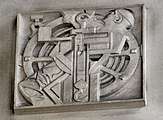 "Mechanic". Walthamstow Town Hall Relief Panel
"Mechanic". Walthamstow Town Hall Relief Panel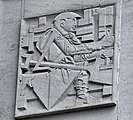 "Navvy". Walthamstow Town Hall Relief Panel
"Navvy". Walthamstow Town Hall Relief Panel "Education". Walthamstow Town Hall sculpture
"Education". Walthamstow Town Hall sculpture "Fellowship". Walthamstow Town Hall sculpture
"Fellowship". Walthamstow Town Hall sculpture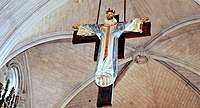 Rood Cross, All Souls, Leeds
Rood Cross, All Souls, Leeds.jpg) Statue of Thomas Burke
Statue of Thomas Burke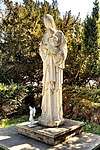 Our Lady of Consolation. Outside Our Lady Queen of Heaven Church, Frimley
Our Lady of Consolation. Outside Our Lady Queen of Heaven Church, Frimley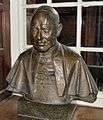 Bust of Cardinal Hinsley
Bust of Cardinal Hinsley Head of Georgia Leprohon
Head of Georgia Leprohon
War Years
Another commission in 1940 was for the Catholic Hospital, Lambeth Road, London. This is a nine foot high limestone statue of Our Lady of Consolation which stood above the entrance to the hospital,[28] so taking foreshortening into consideration. A bronze model, "Madonna and Child", was exhibited at the Royal Academy in 1944. The hospital closed in 1984[29] and the statue is now outside Our Lady Queen of Heaven Church in Frimley, Surrey. His "Greyhound" (1940) was commissioned by two London bookmakers at the Greyhound Racing Association and was cast in silver.[30]
One of his finest portrait busts was the bronze of Cardinal Hinsley which was exhibited at the Royal Academy in 1939 and at the Royal Hibernian Academy in 1947; it is now in the Westminster Cathedral Clergy House Library. Another bust "Russian Peasant", a portrait of a Russian Jew he had ‘found’ on the Mile End Road in London's East End, was exhibited in 1943 and purchased by the Chantrey Bequest for the Tate Gallery.[31] He also exhibited portraits of J.W.Dulanty and Sir Francis Joseph (1937) at the Royal Academy.
He was commissioned to carve five corner figures, for which he received £440,[32] and 16 low reliefs for the Walthamstow Town Hall (1937–1942). The relief figures representing crafts and industries are in the entrance of the Town Hall on the sides of the portico piers and the five figures, which are classical in style, are at the rear on the council chamber. He also carved "Tragedy" and "Comedy" on either side of the Assembly Hall.[33] The five figures represent "Recreation", "Motherhood", "Fellowship", "Education" and "Work". The figure of "Fellowship" is based on William Morris who had lived locally.[34]
He won the competition in 1941 for a limestone statue of Father Burke, the Dominican preacher, holding a cross, for which he received £750. The figure, which stands in Galway, Eire, and is eight feet tall, was completed in 1948.[35][36][37]
Post War
| Statue of "Prince of Preachers" |
|---|
| At Walshe's Quarries, Leighlinbridge, Carlow, I watched Mr. John Kavanagh, F.R.B.S., Offaly born sculptor, finishing his nine-foot limestone figure of the great Father Tom Burke, O.P., "Prince of Preachers." The figure will be Galway's tribute to one of her greatest sons.
With Mount Leinster away on the horizon and amid the clatter of quarrymen's implements on the hard quarry rock, widely travelled John Kavanagh works in an improvised studio almost on the lip of the quarry pit. Since he began the work he has resided in a farmhouse about 3 miles from the quarry. He makes the journey to and fro in an ass and cart. The figure block came out of the pit weighing six tons. When completed the statue will weigh about half that. For 100 years the Walshes have worked their quarry. Mr Kavanagh's head of the late Cardinal Hinsley was exhibited at the R.H.A. exhibition in Dublin last year. During his studies in Rome, he met the present Pope, then Cardinal Pacelli, and Signor Mussolini.[38] |
Also after the war he received a commission from the Ford Company of Dagenham for a statue of Spartacus as a monument to Free Europe. He also submitted designs in 1949 for the competition to design the Holy Door of St. Peter's Basilica in Rome but his models for the bronze doors did not arrive in time.
In 1950 in a joint submission with the architect Daithi P. Hanly he won the Dublin Custom House Memorial competition with a design of Eire striding towards freedom defended by Fionn Mac Cumhaill's last shot. Unfortunately the project suffered delays and was never completed. The model is reported to have been taken to New Zealand.[39]
New Zealand
In 1951 he took up the position of Senior Lecturer in Sculpture at the Elam School of Fine Arts, Auckland, New Zealand, and temporarily acted as head in 1960, retiring in 1968.
He designed the medal for the Medical Research Council of New Zealand in 1951.[40] In 1978 he won the Grand Prix de Lyons with a bronze from the marble head of Georgia Leprohon, a four-year-old child. When in New Zealand he received few commissions.[41] His bronze head of Sir Douglas Robb (1956), exhibited at the Royal Academy in 1957, is on display at the Old Government House and a portrait in oil (1961) is in the University of Auckland.[42] A bronze head of Dr H.D. Robertson (1970) is in the Sarjeant Gallery.
There were retrospective exhibitions of his sculpture at the Auckland City Art Gallery in 1979 and of his paintings and drawings at the Auckland Society of Arts in 1980.[43][44]
Works Exhibited at the Royal Academy
| Year | Title | Type |
|---|---|---|
| 1933 | Tanith | Bronze statue |
| Wanda Tiburzzi | Bronze bust | |
| Il Vecchio | Bronze head | |
| 1934 | Colin St Clair Oakes | Bronze head |
| Not named | Bronze head | |
| 1935 | The Dance of the Hours | Relief |
| 1936 | Dr P Duval | Bronze bust |
| 1937 | J.W.Dulanty | Bronze bust |
| Sir Francis Joseph | Bronze head | |
| Half-length portrait | Bronze | |
| 1939 | Cardinal Hinsley | Bronze bust |
| 1943 | Head of a Russian Peasant | Bronze head |
| 1944 | A Talbot | Bronze head |
| Madonna and Child | Bronze statuette | |
| 1946 | Cora Ann | Bronze statuette |
| Torso | Bronze | |
| Cardinal Hinsley | Bust | |
| 1957 | Dr Douglas Robb | Bronze bust |
Personal life
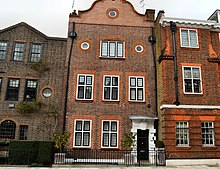
He lived in 'The Little House', Mallord Street, Chelsea, London (1936–1946) with his studios at St. Oswald's Studios, Fulham (1934–1936) and then at Radnor Walk, Chelsea (1936–1943). He also had a studio at his father's house in Whalebone Lane, Chadwell Heath, Essex. In 1947 he gave his address as Lower Baggot Street, Dublin. In 1951 the family were at Upper Gardiner Street, Dublin and in 1984 at Greenlane Rd, Remuera, Auckland. In 1958 the family returned to Britain during his sabbatical leave.
He was married at Chelsea in 1942 to Jane Ella Cove (b 1892, Wimbledon), who died the following year leaving him a substantial amount[45]. His second marriage in 1950 was to Margaret O'Connor (1922-2004), known as Peggy, and they had two children, John (b 1950) and Carol (b. 1949). He died of a heart attack in Auckland, New Zealand and is buried in Purewa Cemetery.[46]
| Wikimedia Commons has media related to John Francis Kavanagh. |
References
- "The British School at Rome Scholarship in Sculpture". Mapping the Practice and Profession of Sculpture in Britain and Ireland 1851-1951, University of Glasgow History of Art and HATII, online database 2011. Retrieved 23 February 2017.
- Snoddy, Theo (1996). Dictionary of Irish Artists: 20th Century. Wolfhound Press Ltd. pp. 222–224.
- "John Francis Kavanagh". Mapping the Practice and Profession of Sculpture in Britain and Ireland 1851–1951. University of Glasgow History of Art and HATII, online database 2011. Retrieved 23 February 2017.
- Email from the Archives & Collections Manager, Library, Royal College of Art. (2017)
- "Charles Sargeant Jagger", Yorkshire Evening Post 16 November 1934 p13
- "Workers Lifting a Steel Construction (Ireland, 1930)". Peter Nahum at the Leicester Galleries.
- "Workers Lifting Steel (1930)". Young & Son Antiques & Fine Art.
- Chamot, Mary; Farr, Dennis; Butlin, Martin (1964). The Modern British Paintings, Drawings and Sculpture. London: Oldbourne P.
- "The British School At Rome". Times [London, England] (Issue 45416). 21 January 1930. p. 17.
- "Mother And Two Children Plaster". FindArtInfo.com.
- Martin, Simon (2016). The Mythic Method: Classicism in British Art 1920-1950. Chichester: Pallant House Gallery. p. 35. ISBN 9781869827892.
- Reports of the Executive Committee and Faculties, April 1934. British School at Rome. Email from the Archivist.
- "Bronze Medal for Leeds Sculptor", Yorkshire Evening Post, 9 October 1935 p3
- "Tanith". Mapping the Practice and Profession of Sculpture in Britain and Ireland 1851–1951.
- "Tanith". The University of Auckland Library and Learning Services.
- Yorkshire Evening Post, 4 December 1933 p10
- "Head of Leeds School of Sculpture Resigns", Yorkshire Post and Leeds Intelligencer, 24 January 1939 p7
- Founder's Gift to Leeds School, Yorkshire Evening Post, 19 September 1936 P7
- Email from the PA to the Headteacher , Roundhay School. (2017).
- "CORA ANN: THE SPIRIT OF YOUTH". Whyte's.
- "Motivated to medal". RIBA Journal.
- Email from the National Society of Painters, Sculptors & Printmakers with extracts from their Exhibition Catalogues. May 2017.
- Email from the Academy Co-ordinator, Royal Hibernian Academy, Dublin. (2017). With copy of works exhibited.
- "John Francis Kavanagh sculpture at Auckland City Art Gallery (Lady Jane?)". The University of Auckland Library and Learning Services.
- Email from the Collection Curator, Aigantighe Art Gallery, Timaru, New Zealand. (2017)
- A Leeds Church Memorial, Yorkshire Evening Post, 10 February 1939 p8
- Memorial Cross, Yorkshire Evening Post, 29 December 1939 p6
- "Roman Catholic Ceremony". Times [London, England] (48795). 10 December 1940. p. 6.
- "Catholic Nursing Institute". LOST HOSPITALS OF LONDON.
- "Greyhound". The University of Auckland Library and Learning Services. Retrieved 17 August 2017.
- "Russian Peasant c.1935–9". Tate Britain.
- "New Town Hall Committee", Walthamstow Borough Council minutes, 9 December 1938, pp 136-137
- "Tragedy Head". Public Monuments and Sculpture Association National Recording Project. Archived from the original on 22 February 2017.
- "Fellowship (William Morris)". Public Monuments and Sculpture Association National Recording Project. Archived from the original on 19 June 2018.
- "Thomas Burke – Tomás de Búrca". Statues – Hither & Thither. René & Peter van der Krogt.
- Catholic Standard, Friday 24 January 1941 page 2
- "In Memory of Father Tom", Catholic Standard, 3 December 1948 p1
- "Statue of Prince of Preachers", Catholic Standard, 23 January 1948 p2
- Murphy, Paula (2014). Art and Architecture of Ireland, Volume III, Sculpture 1600–2000. Yale University Press. pp. 189–190.
- Wolfe, Richard (2017). "Return to Order: The Classicism of John F. Kavanagh". Art New Zealand. 164: 92–97.
- Dunn, Michael (2002). New Zealand Sculpture: A History. Auckland University Press. p. 67 – via Google books.
- "Sir Douglas Robb". The University of Auckland Art Collection.
- "John F. Kavanagh, sculptor: an exhibition of sculpture and models from the collection of the artist, Auckland City Art Gallery, August 29-October, 1979". Auckland Art Gallery.
- "The Sculptures, Paintings & Drawings of John Francis Kavanagh". Originally published in Art New Zealand 18 Summer 1981.
- Kavanagh Jane Ella, Probate 1943
- Sculptor Painter Dies Aged 80. New Zealand Herald 21 June 1984 sec 1 p 20.